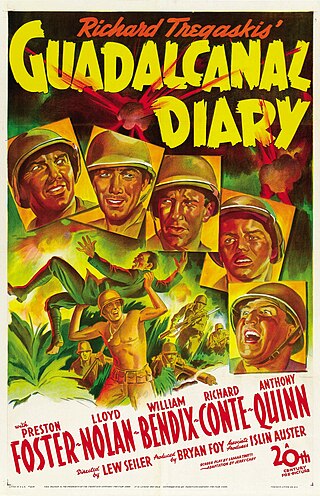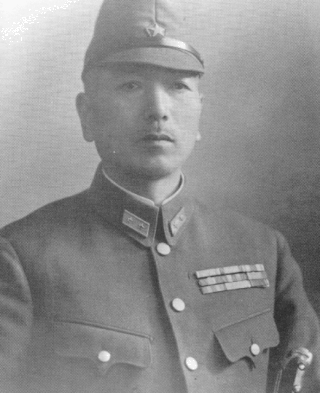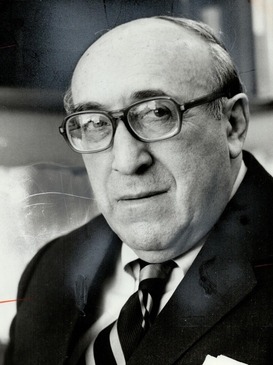Synopsis
The book chronicles the author's experiences as a war correspondent for the International News Service (INS) during the first seven weeks of the Guadalcanal campaign, from the first landings on August 7, 1942 to his departure on September 26, 1942. [5] Tregaskis was also around for Operation Dovetail, a practice run for the Guadalcanal landings, but while he was on board one of the troop transports involved, his book does not cover the operation or him being at Koro Island, where the operation took place. [6]
Tregaskis relates combat and conversation in vernacular, citing the full name, rank, and hometown of each of the Marines he encountered during the weeks he was on the island.
Background
During his time on the frontlines with troops from the United States Marine Corps, Tregaskis wrote down what he saw onto various small notebooks, which he stored in his pockets and had numbered for easier reference. At night, he would compile the information into his diary, adding references to specific books in the event he wanted to publish his journal as a full-length book. [4]
On September 25, Tregaskis flew out of the island to New Caledonia and then boarded a flight for Honolulu, where he began writing Guadalcanal Diary. Due to wartime media regulations, he had to write the book under supervision at the Navy offices at Pearl Harbor, and his diary was kept in a safe during the night. (Tregaskis never got the diary back.) [4] According to a follow-up essay Tregaskis wrote in 1964, his manuscript was subject to military censorship by the Office of Naval Intelligence. For example, one of the Naval Intelligence officers excised a portion about Japanese encampments smelling "sweet-ish"; the officer, according to Tregaskis, was "apparently" worried about Japanese troops reading the book and using deodorant to hide their camps. [7]
Tregaskis finished his manuscript in November 1942 and sent it over to Barris Faris, editor-in-chief of the INS, who in turn sent it over to Ward Greene, head editor of King Features Syndicate. Greene then sent it out to nine other publishers for bidding, an unusual practice at the time. Bennett Cerf, one of the founders of Random House, received his copy on November 11, read it from beginning to end that night, and called Greene the next day to secure publishing rights, anticipating a high demand for stories about the Guadalcanal campaign. Random House rushed Guadalcanal Diary into print and published the book on January 18, 1943. [4]
Reception
Guadalcanal Diary sold over 100,000 copies, becoming the first book by Random House to reach such sales numbers. It occupied the #1 spot on the New York Herald Tribune Best Seller List and The New York Times Best Seller list, [4] staying on the latter for 15 weeks. [8] According to one of the author's later books, it was subsequently made required reading for all USMC officer candidates. [9] A 1943 survey conducted by the American Library Association reported that the book was immensely popular among all age groups, including teenagers and younger children. [10] The book became so widely known that, according to a contemporary article in American Speech , "diary writers" became Army slang for Marines. [11]
Most, but not all, reviewers praised the book's writing style. Irving Brant, a historian and journalist writing for The New Republic , called it "as brilliant a literary style as a wooden Indian" and felt that it was so immersive that adding any literary flourishes would diminish its prose. [12] Writer Marcus Duffield also enjoyed the book's style; in his review for The Nation , he wrote that it was "never a dull diary", citing its "eye for detail, refreshing lack of self-consciousness or artifice, and humor." [13] Similarly, Jacob C. Meyer, a historian and professor at Western Reserve University, opined in a review The Far Eastern Quarterly that Tregaskis never wrote more than what was necessary for understanding. [14] Meanwhile, in his review for the New York Times , John Chamberlain wrote that he felt the book was repetitive at times but still found it enjoyable and recommended it as a "tonic for the war-weary on the homefront". [15] Mark Gayn's review for The Saturday Review of Literature considered it "an honest book", but found it flat and forgettable, suggesting it might have been better had Tregaskis given it more artistic flair. [16] Clifton Fadiman of The New Yorker called it "rough" and "artless" and wrote that it had a "total lack of literary finish," but thought it made up for it with its "on-the-spot quality." [17]
Reviewers generally thought that the book was informative and unbiased. Brant called it a "factual recital" that heightened his understanding of the mindset of the Marines, [12] and Duffield found it generally illuminating, claiming that the news dispatches of the days were so censored and "chopped-up" that they made the Guadalcanal campaign feel unreal. [13] R.L. Duffus, a reviewer for the New York Times , echoed a similar sentiment; he praised Tregaskis and other reporters who saw the conflict first-hand for their ability to elucidate the "sternly stripped facts" of official war dispatches, opining that "American journalism is writing its brightest pages in this war." He also commended Tregaskis for writing about Guadalcanal "without sentimentality or heroics". [18] In contrast, while Meyer did not observe any bias in the book's point of view, he still urged future scholars to consider the limits of its perspective, encouraging them to consider "whether the reporter told all that he knew and thought important or whether he was limited by conditions which did not permit such a report." [14]

Guadalcanal is the principal island in Guadalcanal Province of Solomon Islands, located in the southwestern Pacific Ocean, northeast of Australia. It is the largest island in the Solomons by area and the second-largest by population. The island is mainly covered in dense tropical rainforest and has a mountainous hinterland.

Robert Hugh Leckie was a United States Marine and an author of books about the military history of the United States, Catholic history and culture, sports books, fiction books, autobiographies, and children's books. As a young man, he served with the 1st Marine Division during World War II; his service as a machine gunner and a scout during the war greatly influenced his work.
Gook is a derogatory term for people of East and Southeast Asian descent. Its origin is unclear, but it may have originated among U.S. Marines during the Philippine–American War (1899–1913). Historically, U.S. military personnel used the word “to refer to any dark-skinned foreigner, especially a non-European or non-American.” The earliest published example is dated 1920 and notes that U.S. Marines then in Haiti used the term to refer to Haitians. It was widely used in Asia in both the Korean and Vietnamese Wars.

Guadalcanal Diary is a 1943 World War II war film directed by Lewis Seiler, featuring Preston Foster, Lloyd Nolan, William Bendix, Richard Conte, Anthony Quinn and the film debut of Richard Jaeckel. It is based on the book of the same name by Richard Tregaskis.

Clifton Paul "Kip" Fadiman was an American intellectual, author, editor, and radio and television personality. He began his work in radio, and switched to television later in his career.
Eric M. Hammel was a military historian, with a focus on the military campaigns of the United States Marine Corps in the Pacific War, and other military action in World War II as well as military conflicts including the Vietnam War and the Arab-Israeli Conflict. Hammel wrote a series of books about World War II Flying Aces but his most influential book was The Root : The Marines in Beirut, August 1982-February 1984 on the subject of the 1983 Beirut barracks bombings.

Kiyotake Kawaguchi was a general in the Imperial Japanese Army during World War II.

The Battle of the Tenaru, sometimes called the Battle of the Ilu River or the Battle of Alligator Creek, was a land battle between the Imperial Japanese Army and Allied ground forces that took place on 21 August 1942, on the island of Guadalcanal during the Pacific campaign of World War II. The battle was the first major Japanese land offensive during the Guadalcanal campaign.

Harukichi Hyakutake was a general in the Japanese Imperial Army in World War II. He is sometimes referred to as Haruyoshi Hyakutake or Seikichi Hyakutake. His elder brothers Saburō Hyakutake and Gengo Hyakutake were admirals in the Imperial Japanese Navy.

Robert M. Citino is an American military historian and the Samuel Zemurray Stone Senior Historian at the National WWII Museum. He is an authority on modern German military history, with an emphasis on World War II and the German influence upon modern operational doctrine.

Richard William Tregaskis was an American journalist and author whose best-known work is Guadalcanal Diary (1943), an account of the first several weeks of the U.S. Marine Corps invasion of Guadalcanal in the Solomon Islands during World War II. This was actually a six-month-long campaign. Tregaskis served as a war correspondent during World War II, the Korean War, and the Vietnam War.

Samuel Blair Griffith II was a brigadier general in the United States Marine Corps. Griffith entered the Marines in 1929 after graduating from the United States Naval Academy. He served in and commanded Marine units in the Pacific theater of World War II and retired from service in 1956. After his retirement, Griffith wrote several books and numerous articles on military history and lectured widely. He died on March 27, 1983, in Rhode Island.
Akinosuke Oka was a colonel in the Imperial Japanese Army and a commander of Japanese troops during the strategically significant Guadalcanal campaign in the Pacific theater of World War II. He was posthumously promoted to major general.

Masao Maruyama, was a Lieutenant General and commander in the Imperial Japanese Army during World War II.

Frank Bryan Goettge was a United States Marine Corps intelligence officer in World War II. He led the ill-fated Goettge Patrol in the early days of the Guadalcanal campaign and was killed during that operation.

Mark Gayn, born Mark Julius Ginsbourg was an American and Canadian journalist, who worked for The Toronto Star for 30 years.

Robert Lee Sherrod was an American journalist, editor and writer. He was a war correspondent for Time and Life magazines, covering combat from World War II to the Vietnam War. During World War II, embedded with the United States Marine Corps, he covered the battles at Attu, Tarawa, Saipan, Iwo Jima, and Okinawa. He also authored five books on World War II, including Tarawa: The Story of a Battle (1944) and the definitive History of Marine Corps Aviation in World War II (1952). He was an editor of Time during World War II and later editor of The Saturday Evening Post, then vice-president of Curtis Publishing Company.

World War II in HD is a History Channel television series that chronicles the hardships of World War II, using rare films shot in color never seen on television before. The episodes premiered on five consecutive days in mid-November 2009, with two episodes per day. The series is narrated by Gary Sinise and was produced by Lou Reda Productions in Easton, Pennsylvania.

The Conquering Tide: War in the Pacific Islands, 1942–1944 is the second volume in the Pacific War trilogy written by best selling author and historian Ian W. Toll. The book is a narrative history of the middle phase of the Pacific War, which took place in the central and southern Pacific between the Allies and the Empire of Japan. It was published by W. W. Norton & Company in 2015 and 2016 (paperback). It was released as an audiobook narrated by P. J. Ochlan by Recorded Books in 2015. The first volume in the trilogy, Pacific Crucible: War at Sea in the Pacific, 1941–1942, was published in 2011; the final volume in the trilogy, Twilight of the Gods: War in the Western Pacific, 1944–1945, was published in 2020.
This is a Bibliography of World War II battles and campaigns in East Asia, South East Asia, India and the Pacific. It aims to include the major theaters, campaigns and battles of the Asia-Pacific Theater of World War II. It is part of Wikipedia's larger effort to document the Bibliography of World War II. Its counterpart for the European, North African and Middle Eastern theater is the Bibliography of World War II battles and campaigns in Europe, North Africa and the Middle East.
















